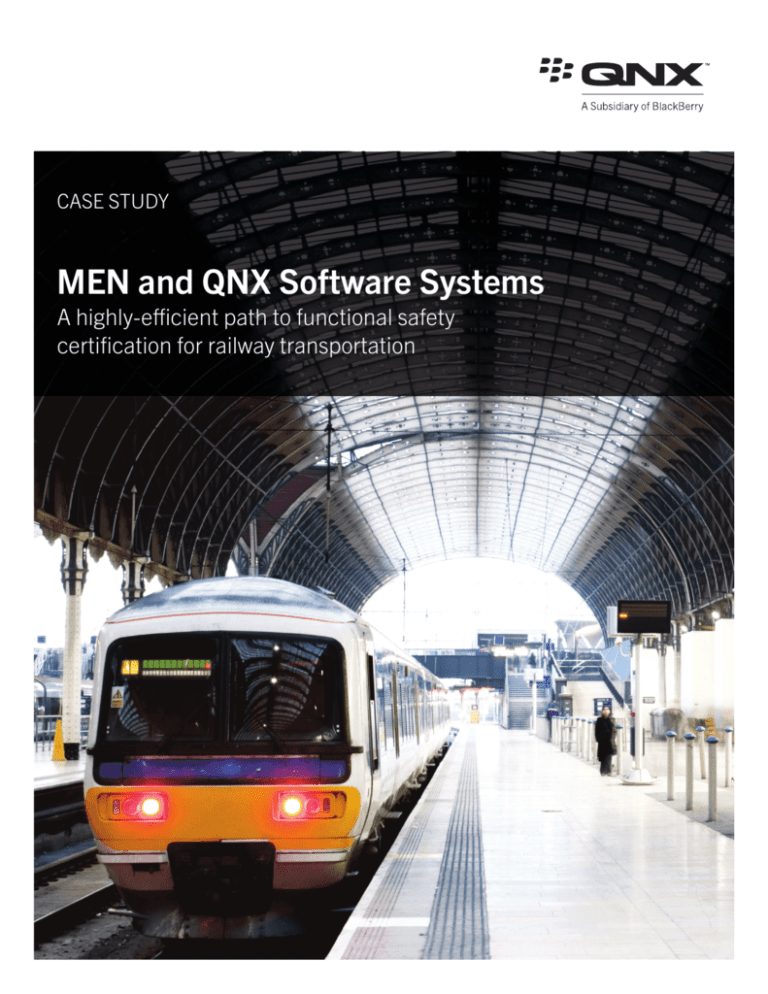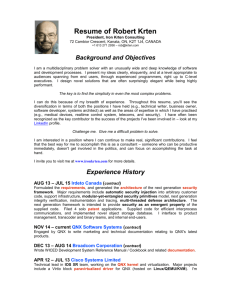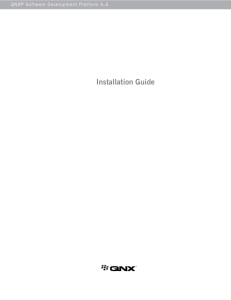
CASE STUDY
MEN and QNX Software Systems
A highly-efficient path to functional safety
certification for railway transportation
Terry stares at his project proposal on the table for the fifth time that morning.
The title reads: Project Proposal – Automatic Train Protection System (Certified to
EN 50128 SIL 4). Although Terry has managed the development of multiple technology
systems in the past, this project is different and has cost him several nights of sleep.
Customer Snapshot
Company
MEN Mikro Elektronik GmbH
www.men.de
@MEN_Germany
info@men.de
Terry is a seasoned project manager from the industrial automation sector who recently
joined a rail transportation manufacturer. With his engineering background, Terry has
no problem understanding the technical aspects of the new project he is taking on, related
to automatic train protection. Drawing up a project outline, complete with development
schedule and budgetary figures, would usually take less than two weeks if he were not stuck.
This being Terry’s first safety certified project he is grappling with how to get EN 50128
approval at the system level for the hardware and software. Numerous questions swirl
around in Terry’s head, each threatening to undermine the usual knowledge that Terry
has for estimating schedule and budget.
“What hardware platform should we choose to make the EN 50128 certification easier?”
Headquarters
“Which COTS components should we use?”
Nuremberg, Germany
“What design implications does EN 50128 have on the overall system?”
Founded
1982
Number of Employees
Approximately 290 worldwide
About
Offers highly reliable embedded COTS
boards and devices widely used in extreme
environmental conditions found in
industrial and safety-critical application
Certified to ISO 9001, ISO 14001
(environment), EN 9100 (aerospace)
and IRIS (railway)
Sales and support network
§§
§§
§§
§§
MEN GmbH, Germany
MEN S.A.S., France
MEN Micro Inc., USA
Worldwide distribution
“How much does certification cost?”
“How do we mitigate the risk of a failed certification attempt?”
“Are there any existing expertise in our development team on the application of the
EN 50128 standards?”
“How does the EN 50128 requirement impact the overall schedule? Would it double
the project length?”
A Harvard Business Review article surveying a sample of large IT projects showed that
on average 45% of the projects run over budget, 7% over time and 56% deliver less value
than predicted. Terry never thought these statistics would apply to any project he managed,
based on his experience and industry knowledge. Now, faced with a new requirement
for functional safety certification, Terry has a fresh appreciation for these numbers.
The Problem
Terry’s problem is commonly found in many industries, including railway transportation,
power and energy, factory automation, to name a few. Basically any system whose
malfunction could lead to damages to human or properties is a candidate for functional
safety regulation. There is an increasing adoption of functional safety standards in
different markets, resulting in a number of market specific standards. EN 50128 is one
such example. Based on IEC 61508, the standard governs the functional safety for heavy
and light rail systems. The EN 50128 standard, which was published in 2011, and used
in draft before then still confuses many system manufacturers who are unprepared for the
implication of certification requirements, basically how such requirements impact project
budget and time. A common mistake for less-experienced companies is gross underestimation of this impact which can lead to market timing errors and lost revenue.
The knowledge level for functional safety and certification is
one of the most important deciding factors for project success.
Generally speaking, a project with functional safety certification
requirements can easily double or triple the time it takes to
complete a project without. Efforts invested in certification
activities are often greater than efforts in straight development.
This magnifying effect of the certification requirements is abated
when knowledge level is high and amplified when knowledge level
is low. The table below shows a fictitious scenario to illustrate this
effect, assuming a development team with fairly
good knowledge in safety and certification.
Newcomers to functional safety standards may find this increase
in effort level to be inhibitive. However, a closer look at the standards’
demand help explain this. Take IEC 61508 for example. The safety
integrity levels of IEC 61508 range from SIL 1, the lowest level
to the highest at SIL4. To provide a sense of how demanding
these certifications are, a system certified at SIL 3 must have a
probability of dangerous failure below 1 in 10 million per hour
of operation. Achieving such a low risk of failure is non-trivial,
to say the least. In fact, it’s well-nigh impossible to satisfy these
functional safety requirements unless they are baked into the
very design of the product. This type of design strategy for safety
products is reflected by the increase in both developer head
count and activity duration in the table above. Demonstrating the
compliance to these requirements, to an independent auditing
firm, adds a whole realm of new challenges of its own, which could
easily stretch the project duration by more than 100%.
So how do today’s system vendors meet the challenge of
increasing regulatory pressures for safety standard compliance
in the face of increasingly compressed time-to-market windows?
The Solution
The MEN Modular Train Control System (MTCS) is a perfect
demonstration of the three aspects of a highly-effective solution
to this problem. First, embed functional safety concepts throughout
the entire design lifecycle. Second, leverage pre-certified
components wherever possible. Last but not least, use modularity
to control project scope. MEN was able to deliver this sophisticated
product with proven pedigree in functional safety in a timely fashion.
In turn, the MTCS product is itself a pre-certified component, a critical
ingredient of an effective solution for all railway system builders.
MTCS is a platform designed for safety-critical train applications
like train control, automatic train operation (ATO), automatic
train protection (ATP), and positive train control (PTC)/enhanced
train control (ETC). These applications range in certification
requirements from ATO typically at a EN 50128 SIL2 level to signal
interlocking requiring a EN 50128 SIL4 certification. Available in
an EN 50128 SIL 4 pre-certified configuration, the MTCS provides
safe control of single functions as well as for complete train
control. By changing its configurable setup, the MTCS can control
anything in the train that requires functional safety – under SIL 4,
SIL 3 or SIL 2 requirements. MTCS is developed according to
EN 50128 and EN 50129 standards.
Project without
Certification Requirements
Project with
Certification Requirements
12 people
18 people
System Design
5 weeks
8 weeks
Detailed Design
3 weeks
5 weeks
Coding
4 weeks
5 weeks
Testing
6 weeks
12 weeks
Certification
–
20 weeks
Total Budget
$1.2 M
$3 M
Project Duration
8 months
24 months
Developer Head Count
Key Activities Duration (lapse in time)
Table 1: Project Comparison – Certified vs. Non-Certified Product
Using pre-certified components lower overall risk to system
manufacturers through proven and reliable technologies. One
of the most vital components in complex platforms consisting
of hardware and software is the real-time operating system. A
pre-certified operating system (OS) offers a high level of reliability
and risk reduction for safety-critical systems that has been
independently validated. It would be difficult to imagine a certified
industrial control application without a pre-certified OS. This is
an additional dimension to the build-or-buy decision for system
manufacturers. Some companies have legacy home-grown
components including operating systems. In most cases, the cost
of certifying these home-grown components will outweigh the
price tag of a pre-certified solution, simply due to the economy of
scale factor. Hardware is a different story. Pre-certified hardware
is difficult to find and hardware certification is a frequentlyasked question from system manufacturers. By including their
customer-designed hardware in the scope of certification, MEN
has effectively solved this problem for their customers. The QNX
Neutrino RTOS (realtime operating system) is certified to IEC
61508 Safety Integrity Level 3 (SIL 3), and offers a very high level
of reliability and risk reduction for safety-critical systems. It plays
a major role in building secure, survivable embedded systems. By
adopting the QNX pre-certified RTOS, MEN effectively shortened the
project by approximately two years, reduced project cost by about
$2 million and eliminated any certification risk on the OS level.
To control project scope, which translates to project cost,
modularity is the key word. At the heart of the MTCS lies the
F75P – the central computing part of onboard applications like
Train Management Control Systems or Train Protection Systems.
Figure 1: Modular characteristic of the MEN design
The F75P is a COTS safe computer with onboard functional safety
that unites three CPUs on one 3U CompactPCI® PlusIO card.
Two independent control processors (CP) with independent DDR2
RAM and Flash and a supervision structure provide safety (the
board becomes a fail-safe subsystem, certifiable up to SIL4).
An I/O processor completes the board with I/O connectivity. With
its clear separation of safe and non-safe subsystems the F75P can
replace multiprocessing systems with CPU redundancy and I/O
by a small-footprint, low-power solution that is flexible for different
types of application scenarios. The communication protocol of
the third CPU was developed in accordance with EN 50159,
which targets safety relevant communication in transmission
systems. This ensures safe communication in the area known as
the black channel, located between the control unit and I/O, for
comprehensive, safe communication throughout the system. The
diagram below is a good illustration of the modular characteristic
of the MEN design.
The modularity concept is also reflected in MEN’s choice of
realtime operating system. The QNX Neutrino RTOS is a based
on the microkernel architecture that enforces strong boundaries
between software processes to prevent any process from affecting
the performance and behavior of other processes. Processes can
damage one another intentionally (via malware) or unintentionally
(via bugs); the QNX Neutrino RTOS provides mechanisms to
prevent such damage and to keep the system in a healthy state.
Furthermore, the adaptive partitioning technology found in the
QNX Neutrino RTOS provides this level of separation for CPU
bandwidth. A modular design at the system level is only possible
if it is built on a platform that supports this.
Conclusion
The MEN Modular Train Control System offers a pre-integrated,
ready to install platform that combines the ideal operating system
from QNX Software Systems for reliability and easier programming
of safety critical applications with the F75P solution, representing
an extremely compelling offer to address regulatory pressures
and cost effectiveness challenges.
In addition to pre-certification credentials, MTCS offers high level
of flexibility for system integrators, resulting in significant cost and
time savings during computerization of the train. The combined
solution allows users to quickly create new solutions which take
advantage of the latest industrial safety and processing speed
and real-time automation technology while allowing them to reuse
or adapt existing automation algorithms.
So, for Terry, many of his concerns can be addressed with the
selection of a reliable, pre-certified component such as the MTCS.
This approach largely removes the unknowns in project planning,
both in time and budget. Adoption of such a pre-certified COTS
system also represents the most effective solution for many
companies, freeing up internal resources to focus on true
competitive differentiators. Last but not least, choosing a supplier
with good knowledge in functional safety and certification
sometimes provides the shortest path to access that knowledge
in the most relevant manner.
About QNX Software Systems
QNX Software Systems Limited, a subsidiary of BlackBerry, is a leading vendor of operating systems, development tools, and professional
services for connected embedded systems. Global leaders such as Audi, Cisco, General Electric, Lockheed Martin, and Siemens depend
on QNX technology for vehicle infotainment units, network routers, medical devices, industrial automation systems, security and defense
systems, and other mission- or life-critical applications. Founded in 1980, QNX Software Systems Limited is headquartered in Ottawa,
Canada; its products are distributed in more than 100 countries worldwide. Visit www.qnx.com
qnx.com
© 2015 QNX Software Systems Limited, a subsidiary of BlackBerry. All rights reserved. QNX, Neutrino are trademarks
of BlackBerry Limited, which are registered and/or used in certain jurisdictions, and used under license by QNX Software Systems
Limited. All other trademarks belong to their respective owners. MC433.97







